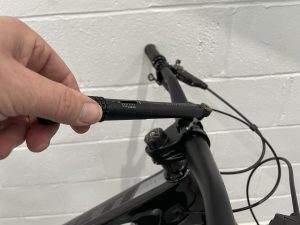Fuel EX 5 Plus eats up boulders and roots on the descents
Trek Fuel EX 5 27.5 Plus (2017) review
For 2017, Trek has completely reworked its Fuel EX platform. Not only has it increased the travel to 130mm, it now offers two versions: one with 29in wheels, and a 27.5 Plus bike with massive 2.8in tyres. And it’s this bike that we’ve tested here.

Both models share the exact same frame, but the Plus bikes get 140mm travel forks, 10mm more than the 29ers. The extra fork length helps raise the bottom bracket height and offset the fact that Plus wheels come up smaller than 29in wheels.
Trek isn’t the only brand to adopt this two-wheel size, single frame approach, but its Mino-Link gives a distinct advantage. This small, asymmetric chip in the rocker link allows you to change the seatstay position relative to the link, which in turn changes the geometry.
In the high position, with Plus wheels, the BB height is roughly the same as the 29er in the low setting. As such, the Plus bike ships in the high position, but there’s nothing to stop you running it in the lower/slacker setting.

Rubber bumper adds belt and braces protection
One new feature on the Fuel EX frame is the Straight Shot down tube. According to Trek, it’s stiffer and lighter than the gooseneck profile normally used to achieve the necessary fork crown clearance.
Trek gets around the clearance issue with a steering lock that prevents the fork crown ever reaching the down tube.
Full steering lock is about 53° in either direction, and we’ve only hit the stop once while riding, on a particularly tight switchback climb.
Suspension
Trek may have bumped up the travel on the Fuel EX, but it hasn’t taken away any of the signature features that made its suspension great. It’s still got ABP (Active Braking Pivot) to help keep the rear wheel tracking when the rear brake is applied, and there’s a metric size shock with increased overlap for improved reliability.
We’re not really fans of lock-outs, and while the one on the RockShox Deluxe is solid, we’d prefer a setting that firms up the suspension for climbing, but doesn’t make the rear suspension totally redundant.
Guide pressures printed on the lower legs of the RockShox Sektor Silver fork proved to be surprisingly accurate, but even with the rebound damping set fully open, the fork felt a little sluggish to return, so light riders running lower pressure will struggle to get the optimum set-up.

Tubeless-ready rims spell less sighs and more highs
Components
Trek states that the Fuel EX 5 comes with a 750mm handlebar, which sounds ideal. Unfortunately, the bike actually has a 720mm bar, which is at odds with its progressive geometry and attitude. Thankfully, it gets a 60mm stem, so all is not lost.
Probably the biggest oversight in the specification is that it doesn’t get a clutch rear mech. As such, the Fuel EX is more prone to dropping the chain, and it’s noisy as hell, even with the rubberised chainstay protector.

Check your Mino-Link bolts — ours fell out
Performance
Setting up the Trek was a doddle. And seeing as we weren’t clipping pedals in the high geometry setting, we quickly flipped the Mino-Link to the low position to take advantage of the slacker head angle. All was golden until one of the Mino-Links fell out mid-ride.
Thanks to Head For The Hills bike shop, in Dorking, we were back up and running the very same day, and this time we added a spot of Loctite to the bolt.
In the right conditions, the Fuel EX 5 Plus eats up boulders and roots on the descents, and this encourages you to ride off the brakes.
Bontrager’s Chupacabra 2.8in tyres also provide unparalleled traction on the climbs, making the most painful part of your ride that much easier. They also roll surprisingly quickly, but the profile is very rounded, so the bike can start to slide in corners before you even reach the side knobs.
Get it on some sloppy waterlogged singletrack and it’s even more difficult to keep it moving in a straight line — and that’s with our £220 Maxxis tyre upgrade.

















